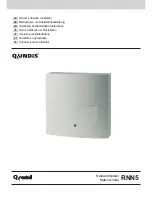
B
ASIC
IP C
ONFIGURATION
36-23
Table 36-3 show ipv6 interface - display description
Field
Description
VLAN
A VLAN is marked “up” if the router can send and receive
packets on this interface, “down” if a line signal is not
present, or “administratively down” if the interface has been
disabled by the administrator.
IPv6
IPv6 is marked “enable” if the router can send and receive IP
traffic on this interface, “disable” if the router cannot send
and receive IP traffic on this interface, or “stalled” if a
duplicate link-local address is detected on the interface.
Link-local address
Shows the link-local address assigned to this interface
Global unicast
address(es)
Shows the global unicast address(es) assigned to this
interface
Joined group
address(es)
In addition to the unicast addresses assigned to an interface,
a node is required to join the all-nodes multicast addresses
FF01::1 and FF02::1 for all IPv6 nodes within scope 1
(interface-local) and scope 2 (link-local), respectively.
FF01::1/16 is the transient node-local multicast address for
all attached IPv6 nodes, and FF02::1/16 is the link-local
multicast address for all attached IPv6 nodes. The node-local
multicast address is only used for loopback transmission of
multicast traffic. Link-local multicast addresses cover the
same types as used by link-local unicast addresses, including
all nodes (FF02::1), all routers (FF02::2), and solicited nodes
(FF02::1:FFXX:XXXX) as described below.
A node is also required to compute and join the associated
solicited-node multicast addresses for every unicast and
anycast address it is assigned. IPv6 addresses that differ only
in the high-order bits, e.g. due to multiple high-order
prefixes associated with different aggregations, will map to
the same solicited-node address, thereby reducing the
number of multicast addresses a node must join. In this
example, FF02::1:FF90:0/104 is the solicited-node multicast
address which is formed by taking the low-order 24 bits of
the address and appending those bits to the prefix.
MTU
Maximum transmission unit for this interface.
Summary of Contents for WPCI-G - annexe 1
Page 2: ......
Page 26: ...TABLE OF CONTENTS xxvi ...
Page 36: ...GETTING STARTED ...
Page 72: ...MANAGING SYSTEM FILES 2 24 ...
Page 74: ...SWITCH MANAGEMENT ...
Page 90: ...CONFIGURING THE SWITCH 3 16 ...
Page 245: ...SHOWING PORT STATISTICS 8 33 Figure 8 12 Port Statistics ...
Page 252: ...ADDRESS TABLE SETTINGS 9 6 ...
Page 318: ...CLASS OF SERVICE 12 16 ...
Page 330: ...QUALITY OF SERVICE 13 12 ...
Page 348: ...DOMAIN NAME SERVICE 15 8 ...
Page 404: ...IP ROUTING 17 44 ...
Page 406: ...COMMAND LINE INTERFACE ...
Page 608: ...MIRROR PORT COMMANDS 26 4 ...
Page 644: ...SPANNING TREE COMMANDS 29 28 ...
Page 668: ...VLAN COMMANDS 30 24 ...
Page 686: ...CLASS OF SERVICE COMMANDS 31 18 ...
Page 700: ...QUALITY OF SERVICE COMMANDS 32 14 ...
Page 792: ...IP INTERFACE COMMANDS 36 50 ...
Page 818: ...APPENDICES ...
Page 824: ...SOFTWARE SPECIFICATIONS A 6 ...
Page 828: ...TROUBLESHOOTING B 4 ...
Page 844: ...INDEX Index 6 ...
Page 845: ......
















































